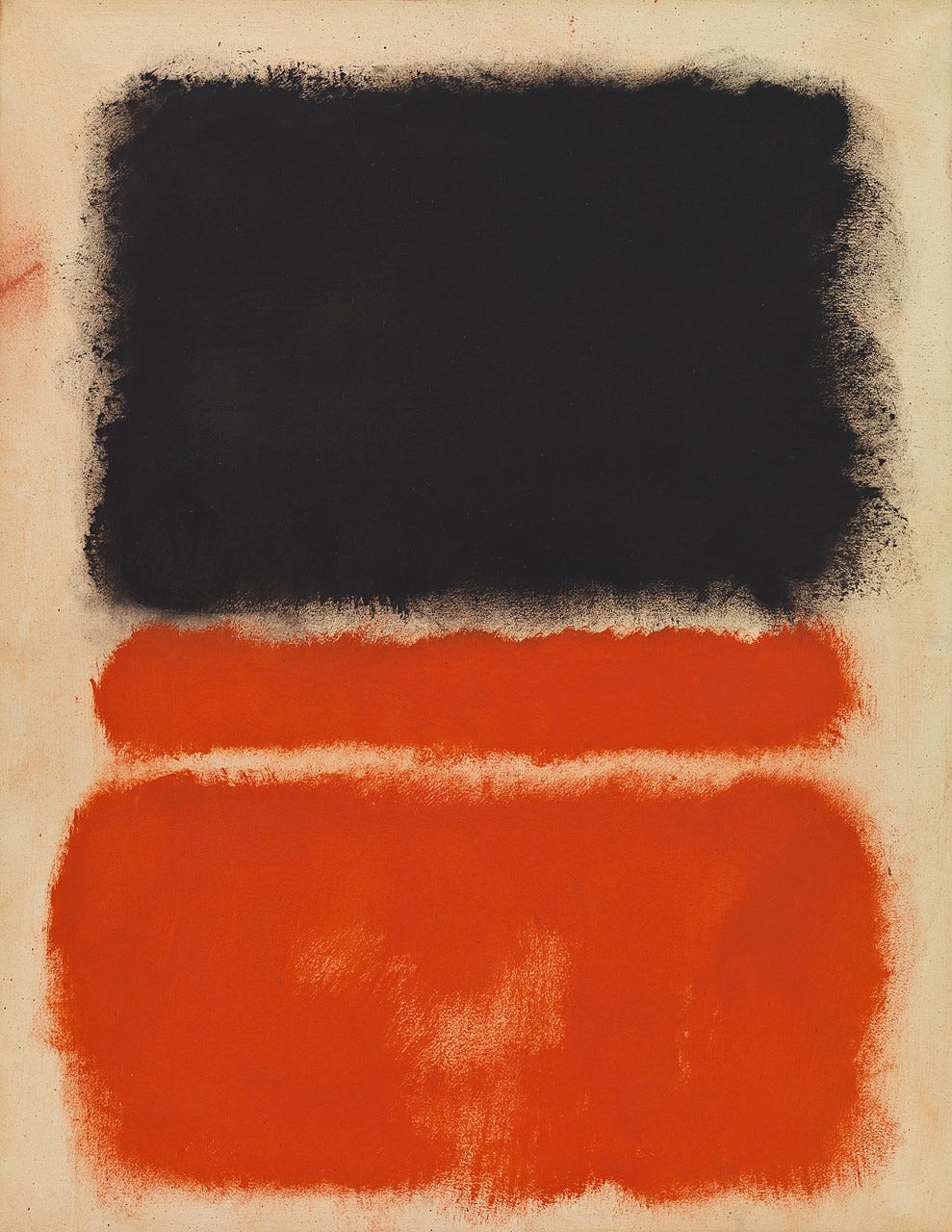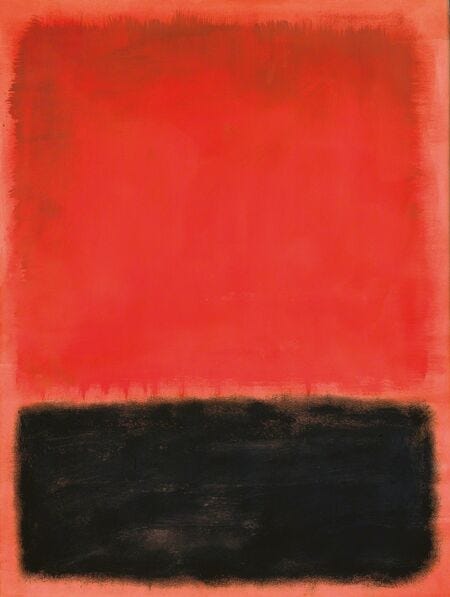Rembering Mark Rothko
What you need to know about Rothko and my obsession with color theory.
Postcards from Somewhere is a reader-supported publication. To receive new posts and support my work, consider becoming a free or paid subscriber.
Hi fam,
Yesterday marked the anniversary of Mark Rothko's death, February 25, 1970. As I sit here reflecting on the artists who have shaped my perception of the world, Rothko stands as a one of those in my “creative board of directors” — meaning: those who fundamentally changed how I understand the power of art and color.
The Vastness of Color
When I first encountered Rothko's work—those huge color fields that seem to breathe and pulsate with life—something changed within me. I remember standing before his "Red on Maroon" at the Tate and feeling physically moved, as though the boundaries between the canvas and my body had somehow dissolved.
Colors floating.
Expanding into space.
Consuming me whole.
Beyond any theory of aesthetics, this experience was about emotion made palpable.
"I'm not an abstractionist. I'm not interested in the relationship of color or form or anything else. I'm interested only in expressing basic human emotions: tragedy, ecstasy, doom, and so on." — Mark Rothko
What Rothko taught me is that color isn't just something we see—it's something we feel, something we experience with our entire being. His vast canvases of layered pigments aren't meant to be merely observed but absorbed, allowing the viewer to be enveloped by their sensory power.
Rectangular portals. Doorways to feeling. Pure emotion in pigment.
The Resonance Today
In 2025, as we navigate a world oversaturated with quick visual stimuli—the endless scroll, the constant barrage of images designed to shock rather than move us—Rothko's work feels more important than ever. His paintings demand what has become increasingly rare: sustained attention, emotional presence, and the willingness to sit with discomfort and complexity.
"A painting is not a picture of an experience, but is the experience." — Mark Rothko
I'm reminded of this when I wrote about "The Zone of Interest" last year—how the film's use of deep, bloody red consumed the screen in a way that immediately brought Rothko's work to mind. Both understand that beauty and horror can coexist, that what appears simple on the surface contains multitudes beneath.
What We Can Learn
In our current moment, where nuance is often sacrificed for immediacy, Rothko's approach offers several profound lessons:
Slowness is revolutionary. Look, his work is not the type of work that you just stare at for a minute and then voila, you move on to the next. His paintings take time to reveal themselves. they do so gradually, rewarding those who give them time. In a world demanding instant reactions, choosing to linger is an act of resistance.
Depth over breadth. Rothko spent years exploring similar forms, going deeper rather than wider. There's power in sustained focus rather than constant novelty. Something I can truly learn from, on a daily.
Emotion as intelligence. He understood that emotional response isn't separate from intellectual understanding—it's integral to it.
"Silence is so accurate." — Mark Rothko
The sacred in the secular. Though not religious in the traditional sense, Rothko created what many experience as spiritual spaces through purely visual means—proving that transcendence can be found in unexpected places.
A Personal Meditation
When I'm stuck creatively, I often think of Rothko's approach. How he reduced everything to its essence. How he trusted viewers to bring their own emotional lives to his work. How he refused to explain or diminish his paintings with words.
Last week, I found myself in a creative rut while working on new material. I closed my laptop, went outside, and spent twenty minutes just looking at the sky as it shifted from blue to deeper blue at dusk.
Pure Rothko. Dusk into darkness. Blue dissolving into night. <3
And somehow, that act of attending closely to color in transition broke something loose in me.
"There is no such thing as good painting about nothing." — Mark Rothko
It's this insistence on meaning, on depth, on the capacity of abstraction to carry profound emotional weight that continues to inspire me. In a time when so much feels superficial, Rothko reminds us to make art that matters, that moves, that insists on emotional truth over easy consumption.
So today, I invite you to find a moment to sit with color. To really see it. To let it work on you in the way Rothko intended. Perhaps that's the best tribute we can offer—not just remembering the artist, but practicing his way of seeing.
Until next time.
Postcards from Somewhere is a reader-supported publication. To receive new posts and support my work, consider becoming a free or paid subscriber.
What else is happening around me:
I've created a new Rothko-inspired playlist
Keep reading with a 7-day free trial
Subscribe to Postcards from Somewhere to keep reading this post and get 7 days of free access to the full post archives.



